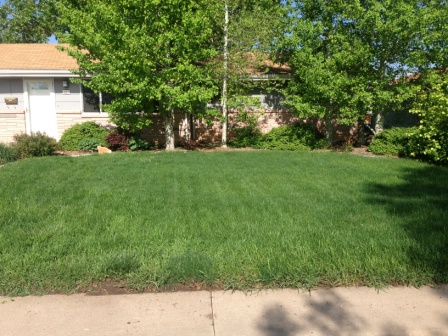Bluegrass and Water Use
After listening to advice given to a customer at a garden center, I realize that, to the general public, there still persists the idea that Bluegrass is unsuitable as lawn turf because of its high water use. As a blanket statement this is not exactly the case! There are many aspects to consider when deciding on what to plant for your lawn.
Basically, there are only a few major varieties of turf-type grass that are suitable for lawns: Kentucky Bluegrass, Fescues and Buffalo Grass. There are advantages and disadvantages to any of these, and of major importance in your choice will be the desired use of the lawn area (play area for children/pets or mostly for viewing and occasional use for lawn games) and the micro-climate of the site (sun/shade/part shade, exposure to wind, soil type and depth, and availability of water and/or a watering system).
Bluegrass varieties are hardy and tough (as in wear-resistant), have good green color, dense growth habit and (quite importantly) the ability to recover from drought or abuse – you can actually stop watering Bluegrass during the Summer for up to 3 months and it will go dormant and turn brown, and it will green up and look good again when water is applied and cooler weather prevails. There are Bluegrass varieties that will do well in somewhat shady sites.
Fescues will be either fine-bladed (Fine Fescues) or course-bladed (Turf-type Fescues) and they need a sunny site. Turf-type Fescues have wider blades than Bluegrass, make a dense lawn that may be as tough as Bluegrass, require mowing at least as much as Bluegrass, use somewhat less water than Bluegrass, BUT they will not recover from extended drought conditions, as they will turn brown and likely die out. Fine Fescues are a native Prairie grass, are deep rooted, require much less water than Bluegrass, are not the dark green that most people want in their lawns (being more of a pale blue-green), are not as thick-growing, wear-resistant nor comfortable to sit or lay on, and still require mowing to look good.
Buffalo Grass is another native prairie grass that requires a sunny exposure. It is probably the most drought resistant and low water use of any grass suitable for lawns. It is mostly blue-green in color, can be quite dense in growth habit, and will require less mowing than the other varieties mentioned here. However, it does not green up in the Spring, rather it waits until really consistent warm weather prevails in late May into June, and it is not as wear-resistant at the others. It is not really suitable for a play area, can be prone to weed invasion (by other grasses and broadleaf plants) if not properly cared for, and will go dormant (turn brown) in early-mid Autumn.
From my experience over many years I still think that for most people a good Bluegrass lawn is the best choice. The bad reputation for Bluegrass being a water-hog comes mostly from past years, maybe decades, of improper treatment due to lack of knowledge of how to care for any lawn – watering too often and not deeply, poor or little soil prep before planting, improper or no fertilization, and the expectation that a lawn should require very little maintenance and management.
Good resources for more understanding of how you can have and maintain a lawn that suits your needs can be found on various web sites:
http://www.ext.colostate.edu/pubs/pubs.html follow links to many different areas…
http://csuturf.colostate.edu/Pages/homelawncare.htm
http://csuturf.colostate.edu/Pages/extensionfactsheets.htm

